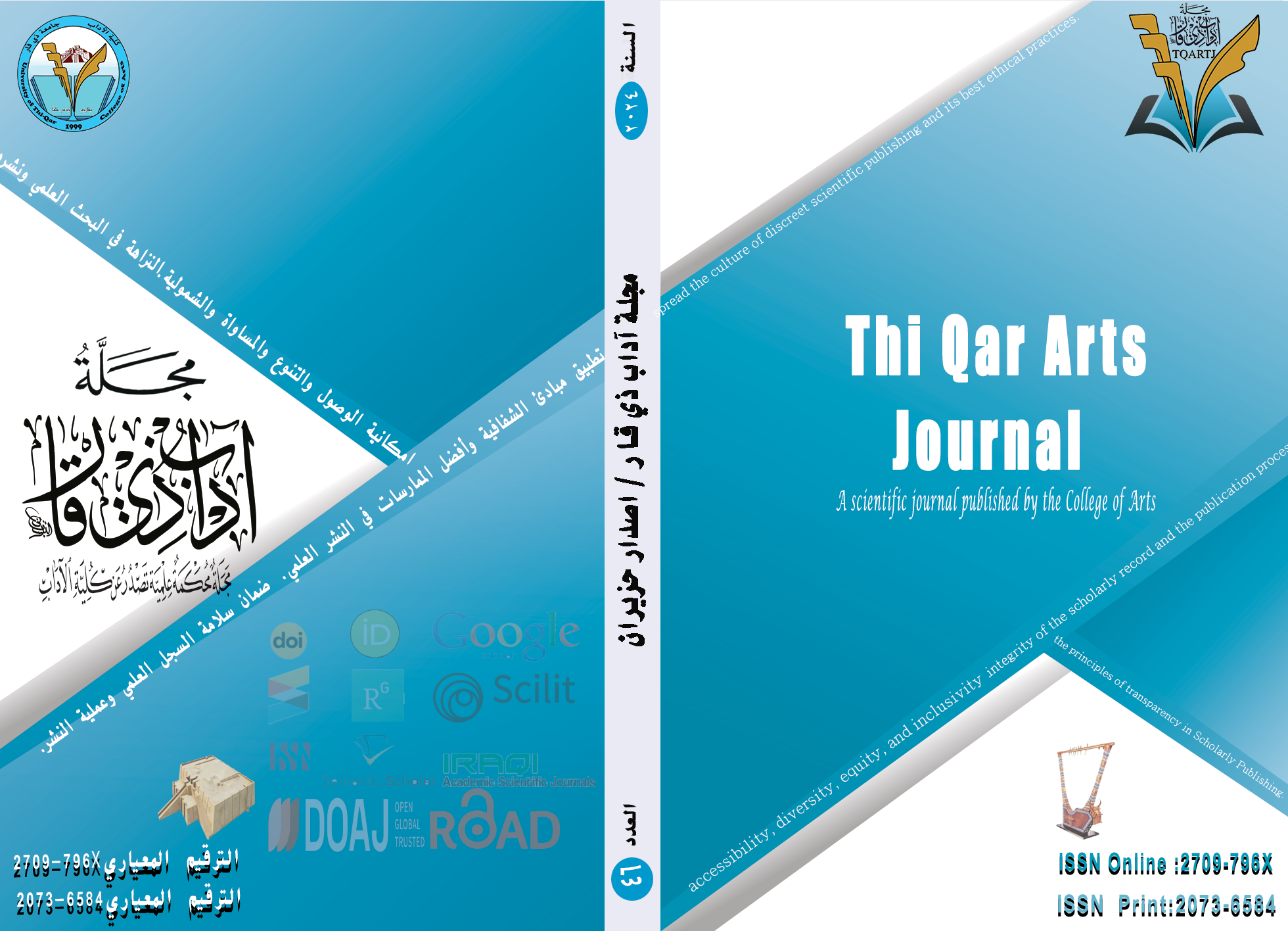The political and religious system according to Arif Al-Saadi
DOI:
https://doi.org/10.32792/tqartj.v4i46.568Keywords:
themm, lmblicitformat, arifalsaady, transfigyration, invisibilityAbstract
It is worth giving our venerable poets academic and research attention, especially the poet Arif Al-Saadi, because he is creative and possesses a conscious text. We have chosen a portion of his huge works, and the choice fell on some of his poems, which contain within them an apparent and implicit political tone, as his poetry was a reflection of reality of the Iraqi people, being a renewed poet in contemporary Iraqi poetry, and one of the signatories of the most prominent modernist phenomenon in Arabic literature, which is the so-called (poetry), became the official spokesman for the people.
This research is concerned with studying the systematic dominant of the expressive formulation of the axis of politics according to what the systematic study started from, which requires creative communication. The inclinations and orientations of the creator became effective in monitoring the meaning, in light of their typicality, far from the possibility of change, and - perhaps this is unfamiliar - in terms of the occurrence of the political and religious pattern, and the extent to which it has the intention, and the poetic mentality of Arif Al-Saadi, through its aesthetics, and in juxtaposition with the grammatical pattern, and he is trying to create a changeable action, keeping pace with the logic of building the human being and the state in the light of human thought, and social justice that has been absent from the ruling authority that he poured his lash of torment upon her.
Downloads
References
The Holy Quran
The Revolutionary Discourse Linguistically and Critically (Studies in the Slogans of the Iraqi Tishreen Uprising), Dr. Khaled Huweir Al-Shams, Dar Dijla Academy, p. 96, 2021.
The Last Adam, Aref Al-Saadi, Dar and Library Adnan for Printing, Publishing, and Distribution, Iraq - Baghdad, 1st Edition, 2019: 79.
Secrets of Rhetoric in the Science of Eloquence, Abdul Qahir Al-Jurjani, edited by Abdul Hamid Al-Hindawi, Dar Al-Kutub Al-Ilmiya, Beirut, Lebanon, 1971.
Poetic Works, Aref Al-Saadi, Dar Sutoor for Printing, Publishing, and Distribution, Iraq - Baghdad, 1st Edition, 2018: 155.
Interpretation of the Problematic Quran, Ibn Qutaybah, explained and published by Al-Sayyid Ahmed Saqr, Al-Maktaba Al-Ilmiya, Beirut - Lebanon, 1st Edition, 1403-1981: 12.
Stylistic Thinking (A Contemporary Vision in Critical and Rhetorical Heritage), Sami Muhammad Ababneh, Irbid: Alam Al-Kutub Al-Hadith, p. 29, 2007.
Representations of the Other, the Image of Blacks in Medieval Arab Imagination, Nader Kazem, p. 95.
The Dialectic of Concealment and Manifestation, Structural Studies in Poetry, Kamal Abu Deeb, Dar Al-Ilm Lilmalayin, Beirut, Lebanon, p. 108, 1984.
Ancient Arabic Narration, Cultural Patterns and Interpretation Issues, Diyaa Al-Kaabi.
Poetry and Poets, Ibn Qutaybah, Dar Al-Hayat Al-Ulum, Beirut, 6th Edition, 1997, pp. 16-17.
Pattern Reading, The Authority of Structure and the Illusion of Immanence, Ahmed Youssef, Al-Dar Al-Arabiya Lil-Uloom Publishers, p. 81, 1st Edition, 1428 AH - 2007.
Kitab Al-Ain, Al-Khalil bin Ahmed Al-Farahidi, p. 218.
Kitab Sibawayh, Abu Bishr Amr bin Uthman bin Qanbar, Vol. 1, edited by Abdul Salam Haroun, Al-Khanji Library for Printing and Publishing, Cairo, 3rd Edition, 1988, pp. 24-25.
Lisan Al-Arab, Ibn Manzur, entry “Nasq”.
Al-Munjid in Language, Literature, and Sciences, Louis Maalouf, entry “Nasq”: 806.
Cultural Transfer, A Reading in Arab Cultural Patterns, Abdullah and Muhammad Al-Ghathami, p. 77.
Downloads
Published
License
Copyright (c) 2024 Hayder Abed Alkhadim- Dr. seyed hosein seydedi

This work is licensed under a Creative Commons Attribution 4.0 International License.
The journal applies the license of CC BY (a Creative Commons Attribution International license). This license allows authors to keep ownership of the copyright of their papers. But this license permits any user to download, print out, extract, reuse, archive, and distribute the article, so long as appropriate credit is given to the authors and the source of the work. The license ensures that the article will be available as widely as possible and that the article can be included in any scientific archive.



















